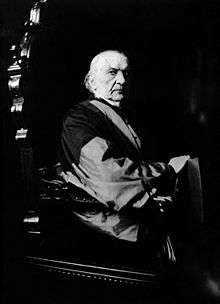Representation of the People Act 1884
|
| |
| Long title | An Act to amend the Law relating to the Representation of the People of the United Kingdom. |
|---|---|
| Citation | 48 & 49 Vict. C. 3 |
| Introduced by | William Gladstone |
| Territorial extent | United Kingdom |
| Dates | |
| Royal assent | 6 December 1884 |
| Other legislation | |
| Repealed by | Representation of the People Act 1918 |
Status: Repealed | |

In the United Kingdom, the Representation of the People Act 1884 (48 & 49 Vict. c. 3, also known informally as the Third Reform Act) and the Redistribution Act of the following year were laws which further extended the suffrage in Britain after the Derby Government's Reform Act 1867. Taken together, these measures extended the same voting qualifications as existed in the towns to the countryside, and essentially established the modern one member constituency as the normal pattern for Parliamentary representation.
The act extended the 1867 concessions from the boroughs to the countryside. All men paying an annual rental of £10 or all those holding land valued at £10 now had the vote. The British electorate now totalled over 5,500,000. An Act a year later redistributed constituencies, giving more representation to urban areas (especially London).
The 1884 Reform Act did not establish universal suffrage: although the size of the electorate was widened considerably, all women and 40% of adult males were still without the vote at the time.[1][2] Male suffrage varied throughout the kingdom, too: in England and Wales, 2 in 3 adult males had the vote; in Scotland, 3 in 5 did; and in Ireland, the figure was only 1 in 2.[2]
The House of Lords balked at the bill so much so that Gladstone was forced in another bill to redistribute the seats.[3]
Key sections of the act
Section 2: This extended a uniform household and lodger franchise, to all parliamentary boroughs and counties in the United Kingdom.
Section 3: Men inhabiting a dwelling-house as an employee, whose employer did not live there, were to be treated as if they were occupying as tenants for franchise purposes.
Section 4: Prohibition of multiplicity of votes. This was not to stop people acquiring multiple votes in different constituencies (plural voting was still permitted), but to restrict sub-division of one property to qualify multiple voters (so called faggot voters).
Section 5a: A man who was a £10 occupier in a county or borough was to be a voter in that county or borough. This assimilated the previous county occupation franchise and borough occupation franchise into a uniform occupation franchise.
Section 6: Occupation in a borough was not to confer a county franchise.
See also
| Wikisource has original text related to this article: |
- Parliamentary Franchise in the United Kingdom 1885–1918
- Medical Relief Disqualification Removal Act 1885
References
- The Statutes: Second Revised Edition, Vol. XVI 1884-1886, (printed by authority 1900)
- ↑ Pilkington, Colin (1999). The Politics today companion to the British Constitution. Manchester University Press. p. 134. ISBN 978-0-7190-5303-0.
- 1 2 Cook, Chris (2005). The Routledge Companion to Britain in the Nineteenth Century, 1815-1914. Routledge. p. 68. ISBN 978-0-415-35970-2.
- ↑ McKechnie, The reform of the House of Lords p.49
External links
Cunningham Glen, W (1885). The Representation of the People Act, 1884, with introduction notes and index. Shaw & Sons.
.svg.png)